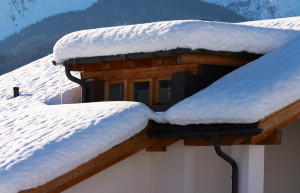Spring may be around the corner, but roof repairs from that blustery winter should top your spring cleaning list. Utah, known for four seasons and sometimes particularly fierce winters, can

For starters, ice dams are a common problem in this part of the country. If an inch or more of snow gathers on your roof, having temperatures dance between above and below freezing is a very destructive pattern and can quickly deteriorate a roof. Particularly troublesome is if you have a warm attic temperature, which makes snow melt faster. Usually this is no problem, but in Utah temperatures can be so frigid that refreezing happens instantly, creating an ice dam that wears down shingles and causes leaks.
Here are a few more winter roof problems to watch out for:
1. Condensation
It is pretty easy to trap moisture via insulation or radiant barriers, and that can deteriorate an entire roof—not just a few problem areas. Beneath the roof structure are purlin beams, and vapor retardants can get caught there. Plus, during the day roofing materials absorb UV energy from the sun. This combination makes heat build up in air pockets between the insulation and roof. That moisture may not be able to easily escape, which can cause serious damage in the attic and also cause leaks or ice dams.
2. Snow buildup
This one is obvious, but snow and icicles that turn your home into a winter wonderland can be disastrous. Specifically, homes with broken or clogged gutters that don’t allow runoff can see problems exacerbated. This can ultimately lead to a collapsed roof. Unfortunately, many homeowners also don’t want to brave the winter weather in order to check for gutter issues, but a professional is happy to do that dirty job.
3. Leaks
Whether it is a leak in the roof itself or the flashing, not all leaks are apparent to the naked eye. Most are small and unnoticeable without a comprehensive inspection. If roofs aren’t “flashed” correctly, leaks can occur. Leaks can lead to extensive damage as well as the growth of black mold, which is potentially fatal to humans.
Shingle damage and improper attic ventilation are also cold weather issues to address. In order to prep for summer, ensure that a roof inspection is scheduled for the spring. Catching issues early is the best way to prevent damage and lower costs.

